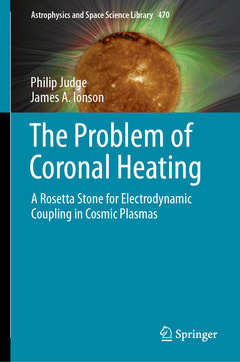The Problem of Coronal Heating, 2024 A Rosetta Stone for Electrodynamic Coupling in Cosmic Plasmas Astrophysics and Space Science Library Series, Vol. 470
Auteurs : Judge Philip, Ionson James A.

This book reflects on 8 decades of research on one of the longest-standing unsolved problems in modern astrophysics: why does the Sun form a hot corona? The authors give a critical overview of the field and offer suggestions on how to bridge the chasm between what we can measure, and what we can calculate. They go back to basics to explain why the problem is difficult, where we have made progress and where we have not, to help the next generation of scientists devise novel techniques to crack such a long-lasting problem. A way forward is formulated centered around refutation, using Bayesian methods to propose and to try to reject hypotheses and models, and avoiding seduction by ``confirmation bias??.
This book is aimed at physicists, students and researchers interested in understanding, learning from and solving the coronal heating problem, in an era of new dedicated facilities such as the Parker Solar Probe and the Daniel K. Inouye Solar Telescope.
Thebook will appeal to those interested in understanding research methods and how they are changing in the modern academic environment, particular in astrophysics and Earth sciences where remote sensing is essential.
Introduction.- Magneto-hydrodynamics.- Challenges.- Methodologies.- Seeking the Sun’s Achilles’ Heels.- Fresh approaches.- Closing thoughts.
Philip Judge began his higher education in physics and choral music as an undergraduate of Magdalen College of Oxford University in 1978. He was awarded a B.A. in physics in 1981 and, in 1985, a D. Phil. degree for his investigation of the outer atmospheres of late-type giant stars. Since 1991, he has worked as a scientist at the National Center for Atmospheric Research in Boulder, Colorado. He was appointed as a Senior Scientist at NCAR in 2004, and is currently working on understanding the basic physics of the Sun's atmosphere.
Driven to mentor and learn from young scientists, his research papers have a strong pedagogical slant. Often they raise more questions than answers. His 2020 book, "The Sun" in the "Very Short Introduction" series from Oxford University Press, has been well received by interested lay-persons and professionals alike. Philip has enjoyed many sabbaticals and visits inuniversities across the globe, privileged to work with many students and staff. His research focuses on the foundations upon which our understanding of the Sun and stars are built, from spectroscopy, spectropolarimetry and radiation transport, to mechanisms by which electrodynamic coupling heats and drives the plasmas surrounding gravitationally bound astrophysical objects. He is an avid fly-tier and fly-fisherman, a lover of international cricket and rugby, a partially successful opera singer, cancer survivor, and author of four fiction books devoted to the climate crisis. He lives with Terri his ever-loving and patient wife of 34 years, with homes in Colorado and Scotland.
James A. Ionson was awarded a Ph.D. in theoretical plasma astrophysics from the University of Maryland in 1977 and was adjunct professor of physics there from 1978-1985 and Senior Scientist and Project Manager at NASA’s Goddard Space Flight C
Date de parution : 03-2024
Ouvrage de 263 p.
15.5x23.5 cm



